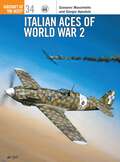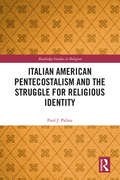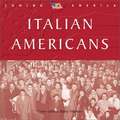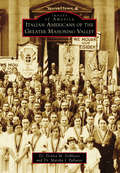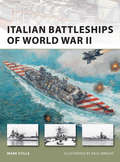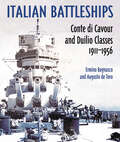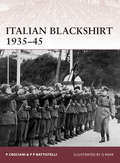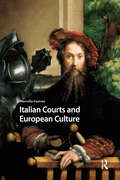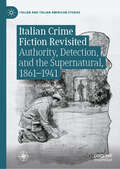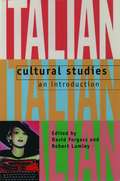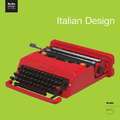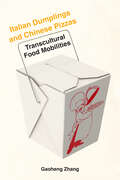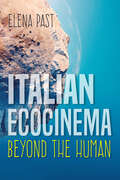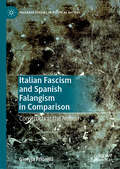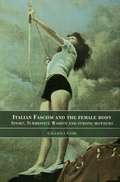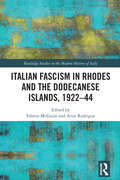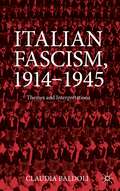- Table View
- List View
Italia '90: Una épica de lo imposible
by Pablo S. AlonsoUn relato completo, dinámico y detallado de Italia '90, la copa mundial de fútbol en la que el seleccionado argentino estuvo a punto de repetir la épica del 86 y que ha quedado marcada a fuego en la memoria emocional de varias generaciones. Posiblemente haya sido uno de los peores mundiales de la era moderna. Posiblemente haya sido, también, uno de los peores equipos argentinos en mucho tiempo. Sin embargo, el Mundial 90 permanecerá marcado a fuego en la memoria de los que lo vivimos. Un equipo repleto de defensores, con el crack averiado, con muchos jugadores en malas condiciones físicas, pero que fue avanzando contra todo pronóstico. Una Armada Brancaleone en pantalones cortos. "Notti magiche", las patadas de los cameruneses, Caniggia en el banco, la derrota inicial, la fractura de Pumpido, el regreso de la Mano de Dios, los centros (errados) de Goyco, Batista homenajeando a la Momia, el pase agónico a octavos, los tiros en los palos de Brasil, el bidón de Branco, el gol de Cani, los penales contra Yugoslavia, el tobillo de Maradona, los silbidos al himno, Zenga tirando un puñetazo al aire, la sonrisa de Cani, los penales de Goyco, siamo fuori, la final, Codesal, las lágrimas de Maradona. Solo algunas de las muchas cosas que se pueden enumerar; una lista no taxativa. Italia '90. Una épica de lo imposible transita cada uno de los caminos y meandros de ese torneo extraño pero entrañable, en el que un equipo alteró su destino a base de obstinación, personalidad y suerte. Con el análisis de cada una de las aristas de ese verano italiano repleto de noches mágicas, Pablo Alonso consigue ingresar al canon de grandes autores -Sasturain, Burgo, Borinsky y Vignone, entre otros- de libros mundialistas.Matías Bauso, autor de 78. Historia oral del Mundial Con mucho material de archivo y numerosas entrevistas a quienes estuvieron ahí, lo vivieron o lo cubrieron en su momento -y con el monumental trabajo de Matías Bauso sobre el mundial de 1978 como referencia-, el periodista Pablo S. Alonso asume la compleja tarea de retratar Italia '90, acaso uno de los últimos mundiales que alcanzaron el aura de campeonato épico en la memoria colectiva. Su exhaustiva investigación reconstruye el contexto -primeros tiempos del menemismo- en que el seleccionado de Bilardo, que venía de ganar el campeonato del 86, viajó a Europa. Quiénes fueron los grandes personajes (Maradona, de alguna manera también Claudia Villafañe, Coppola, Havelange y Grondona; el Pájaro Claudio "Paul" Caniggia; Olarticoechea, Burruchaga y, por supuesto, Goycochea), quiénes los grandes ausentes (Valdano), quiénes los "villanos" (Codesal, el discutidísimo árbitro de la final); cómo fue el negocio (barrabravas; turismo; política), la cobertura mediática, los mitos y rumores; cuáles los trucos del DT (las cábalas y los artilugios no siempre limpios para alentar a los propios y las jugadas sucias para debilitar a los rivales) y cómo fue cada uno de los partidos de Argentina: contra Camerún, Rusia, Rumania, Brasil, Yugoslavia (con el pormenorizado relato de los diez penales que definieron el encuentro), el triunfo sobre el anfitrión y, finalmente, el reencuentro con Alemania. Perfecto para leer escuchando "Un'estate Italiana", conocida popularmente como "Notti magiche", la emotiva canción oficial.
Italian Aces of World War 2
by Richard Caruana Giorgio ApostoloFlying aircraft such as the Macchi 200-202, Fiat G.50 and biplane Fiat CR.42, the Italian fighter pilots were recognised by their Allied counterparts as brave opponents blessed with sound flying abilities, but employing under-gunned and underpowered equipment. Following the Italian surrender in September 1943, a number of aces continued to take the fight to the Allies as part of the Luftwaffe-run ANR, which was equipped with far more potent equipment such as the Bf 109G, Macchi 205V and Fiat G.55. Flying these types, the handful of ANR squadrons continued to oppose Allied bombing raids on northern Italy until VE-Day.
Italian American Pentecostalism and the Struggle for Religious Identity (Routledge Studies in Religion)
by Paul J. PalmaWhile many established forms of Christianity have seen significant decline in recent decades, Pentecostals are currently one of the fastest growing religious groups across the world. This book examines the roots, inception, and expansion of Pentecostalism among Italian Americans to demonstrate how Pentecostalism moves so freely through widely varying cultures. The book begins with a survey of the origins and early shaping forces of Italian American Pentecostalism. It charts its birth among immigrants in Chicago as well as the initial expansion fuelled by the convergence of folk-Catholic, Reformed evangelical, and Holiness sources. The book goes on to explain how internal and external pressures demanded structure, leading to the founding of the Christian Church of North America in 1927. Paralleling this development was the emergence of the Italian District of the Assemblies of God, the Assemblee di Dio in Italia (Assemblies of God in Italy), the Canadian Assemblies of God, and formidable denominations in Brazil and Argentina. In the closing chapters, based on analysis of key theological loci and in lieu of contemporary developments, the future prospects of the movement are laid out and assessed. This book provides a purview into the religious lives of an underexamined, but culturally significant group in America. As such, it will be of great interest to scholars of Pentecostalism, Religious Studies and Religious History, as well as Migrations Studies and Cultural Studies in America
Italian Americans (Coming To America)
by Barry MorenoHere are vivid evocations of New York’s Little Italy and San Francisco’s Italian community around Fisherman’s Wharf, along with the warm family life and neighborhood festivals, the wonderful Italian cuisine, the merchants and tradesmen, the underworld figures, the political leaders, and much more. Brief biographies touch on the lives of physicist Enrico Fermi, politicians Fiorello LaGuardia and Rudolph Giuliani, sportsman Joe DiMaggio, and many others.
Italian Americans of the Greater Mahoning Valley (Images of America)
by Dr Martha Pallante Dr Donna DeblasioBetween 1890 and 1924, Italian immigrants flocked to Ohio's Mahoning Valley. The area's burgeoning iron and steel industries beckoned with job prospects for immigrants fleeing southern and eastern Europe--particularly from southern Italy, a region that at the time lacked opportunity and highly taxed its natives. Upon the arrival of these new residents, neighborhoods such as Youngstown's Smoky Hollow and Brier Hill offered accepting communities, and Niles Fire Brick Factory Company and Trumbull Blast Furnace provided employment. Assimilation was not always easy, and discrimination did occur, but Italian Americans ultimately prospered, making a mark not only as steelworkers but also as shopkeepers, grocers, restaurateurs, tradesmen, educators, doctors, lawyers, legislators, and mayors. This book explores the immigration experience, community, workplace dynamics, celebrations, worship, heritage, and lasting impact of the second-largest ethnic group in Ohio's Mahoning Valley.
Italian Army Elite Units & Special Forces 1940-43
by Pier Battistelli Johnny ShumateItalian military historian Pier Paolo Battistelli examines the elite and specialforces units of the Italian Army during World War II. This includes a vast array of troop types, including paratroopers, assault engineers, sea-landing and swimmer units, long-range recce and ski units, and even hand-picked Fascist 'Mussolini' units. It also delves into the specialist tank and armoured units that were created to emulate the German armoured units. While the Italian units discussed enjoyed mixed success, the volume draws attention to the incredibly hard fighting done by some in the deserts of North Africa and the frozen wastelands of Russia. Illustrated with rare archival photographs and specially commissioned artwork, this is a fascinating insight into a little-studied aspect of Axis forces.
Italian Battleships of World War II
by Paul Wright Mark StilleOften overlooked as a naval power of WWII, Italy's Regia Marina was, upon the declaration of war against France, the fourth largest navy in the world. Despite its numbers, the Italian fleet was made up of largely obsolete vessels, none being equipped with radar, and had a reputation for having inadequately-trained crews. Added to these drawbacks, the Italian commanders did not enjoy the discretion of command at sea that their counterparts in the service of other nations did, being directed closely by the Supermarina (Italian Naval Headquarters). Despite these obstacles, and the heavy losses inflicted upon the fleet by the Royal Navy while in harbour at Taranto, the battleships of the Italian Navy enjoyed a good reputation for being well-designed, and served with courage and determination at Punto Stilo/Calabria, Sirte, Cape Spartivento, and Cape Matapan. Mark Stille details, with the aid of many stunning photographs, including several from the Italian Navy's own archives, the battleships of one of the forgotten navies of WWII.From the Trade Paperback edition.
Italian Battleships: Conte di Cavour and Duilio Classes 1911–1956
by Erminio Bagnasco Augusto de ToroWith the publication of their previous book on the battleships of the Littorio class, the authors set new standards for the detailed coverage and sophisticated analysis of Italian warship design. Inspired by its success, both critically and commercially, the authors were inspired to follow up with a similar study of the earlier Italian battleships that were built in the First World War but survived to fight in the Second. Given the level of new research required, this has taken a decade to achieve but the result is a similarly comprehensive coverage. Originally comprising five ships in two related classes, they entered service at the beginning of the Great War. As designed, they were powerful examples of the second generation of dreadnoughts, with a combination of twin and triple turrets producing a unique main armament of thirteen 12-inch guns. One ship, Leonardo da Vinci, was sunk by an internal explosion at Taranto in 1916, and although the hull was raised post-war, the plan to rebuild the ship was abandoned as it was not deemed cost-effective. However, the remaining four ships were to undergo one of the most radical reconstructions of any battleship class during the 1930s, emerging with an entirely new profile, more powerful machinery and all the characteristics of a modern fast battleship. In this form they became an important element in the Italian fleet that opposed the British after 1940\. This book covers all the technical details of the ships, both as built and as rebuilt, but also provides an extended history of their active service, including battle plans and track charts. Thoroughly illustrated with photographs, ship and armament plans, detail drawings and colour camouflage schemes, the book is a fitting companion to The Littorio Class.
Italian Blackshirt 1935-45
by Pier Battistelli Giuseppe RavaThe Blackshirt legions were raised under army control from 1928, and were employed in 1933 in Libya in counterinsurgency operations against the Senussi tribes; from 1935 in Italy's war against Ethiopia; and during the Spanish Civil War. Following the outbreak of World War II, the Blackshirts fought in North Africa, Greece, Croatia, on the Eastern Front and finally in Italy itself following the Allied invasion.This book documents the experiences of the Italian armed Fascist militia, the Camicie Nere (Blackshirts), from the Italian-Ethiopian war (1935-1936), through the Spanish Civil War (1936-1939) to the end of World War II (1939-1945). It explores their origins, development, recruitment, training, conditions of service, uniforms and equipment, battle experience, political and ideological motivation.
Italian Communism: The Road to Legitimacy and Autonomy
by John A. BakerThroughout the Cold War era, many Americans were puzzled that communism could thrive in Italy, a NATO ally with close cultural and social ties to the United States. In this study of Italian Communism and the Italian Communist Party, from its part in the Resistance during World War II to its role in Italy in the eighties, John Baker explains how Italian Communism differs from communism in other nations and why it has flourished in Italy.Dr. Baker concentrates on the Italian Communist Party’s dilemma regarding its relationship with the Soviet Union. Since World War II, Italian Communists have sought to participate in governing Italy. As long as the Party was associated with the aspirations of the Soviet Union, however, it was suspect in the eyes of the Italian electorate and Italy’s allies. Thus, to gain influence in Italian politics, the Party was forced to “deradicalize,” that is, to disclaim endorsement of non-democratic methods and to distance itself from Soviet foreign policy. Dr. Baker traces this gradual and successful process of deradicalization.
Italian Courts and European Culture (Renaissance History, Art and Culture)
by Marcello FantoniBetween the fifteenth and the eighteenth century, princely courts dominated the Italian political scene. These courts were effervescent centers of cultural production. As such, they became a model for European monarchies who imported Italian courtly forma del vivere (‘style of life’) to legitimize their power and to define social status. This phenomenon included architecture and painting, theater and music, manners and aesthetics, and all the objects, behaviors and beliefs that contributed to homogenize European culture in the age of the Old Regime. It involved a hemorrhage of art and a continuous circulation of people, texts and symbols. The foundational material for this process was classicism and its purpose was political. This delineates a new geography and chronology of a truly European cultural history. It also provides the key traits for the European cultural identity. This book offers a comprehensive reconstruction of the Italian geo-political map focused on courts (thirteenth - seventeenth centuries) and analyses the homogeneity of political forms and of the Italian Christian-Classicist culture.
Italian Crime Fiction Revisited: Authority, Detection, and the Supernatural, 1861–1941 (Italian and Italian American Studies)
by Stefano SerafiniThis book offers the first extensive investigation of Italian crime fiction in the period between 1861, the year of Italy’s unification, and 1941, when the famous Mondadori series ‘I libri gialli’, which had published crime novels since 1929, was suppressed by the fascist regime. By exploring the formal and thematic metamorphoses of Italian crime narratives and probing the different socio-political roles that they played in both the liberal and fascist periods, it provides a radical re-conceptualization, in both historical and theoretical terms, of a form of fiction that has been largely marginalized for both aesthetic and ideological reasons, uncovering how it was implicated in the construction of the modern state and in the articulation and shaping of the process of ‘making Italians’.
Italian Cuisine: A Cultural History (Arts and Traditions of the Table: Perspectives on Culinary History)
by Massimo Montanari Alberto CapattiItaly, the country with a hundred cities and a thousand bell towers, is also the country with a hundred cuisines and a thousand recipes. Its great variety of culinary practices reflects a history long dominated by regionalism and political division, and has led to the common conception of Italian food as a mosaic of regional customs rather than a single tradition. Nonetheless, this magnificent new book demonstrates the development of a distinctive, unified culinary tradition throughout the Italian peninsula.Alberto Capatti and Massimo Montanari uncover a network of culinary customs, food lore, and cooking practices, dating back as far as the Middle Ages, that are identifiably Italian:o Italians used forks 300 years before other Europeans, possibly because they were needed to handle pasta, which is slippery and dangerously hot.o Italians invented the practice of chilling drinks and may have invented ice cream.o Italian culinary practice influenced the rest of Europe to place more emphasis on vegetables and less on meat.o Salad was a distinctive aspect of the Italian meal as early as the sixteenth century.The authors focus on culinary developments in the late medieval, Renaissance, and Baroque eras, aided by a wealth of cookbooks produced throughout the early modern period. They show how Italy's culinary identities emerged over the course of the centuries through an exchange of information and techniques among geographical regions and social classes. Though temporally, spatially, and socially diverse, these cuisines refer to a common experience that can be described as Italian. Thematically organized around key issues in culinary history and beautifully illustrated, Italian Cuisine is a rich history of the ingredients, dishes, techniques, and social customs behind the Italian food we know and love today.
Italian Cultural Studies: An Introduction
by David Forgacs Robert LumleyThis illustrated introduction to the study of modern Italian culture brings together specialists in the fields of language; politics; religious, ethnic, and gender identities; the mass media; cultural policy; and movie stars. In four thematic sections, the contributors elucidate their own slice of Italian culture. Geographies questions received notions of the Italian nation, the family, the "South" and corruption; it also looks at anthropological approaches to culture and at Italy's linguistic pluralism. Identities examines gender, religion, politics, and ethnicity as a means by which people define themselves and others. Media explores the press, literature, television, and cinema. Culture and Society brings together historical analyses of cultural policy, stars and style, and popular music. The book includes guidance for further reading and a chronology of political and cultural events since 1900.
Italian Design (MoMA Design Series)
by Giampiero BosoniThis volume explores Italian design of the last half-century, featuring the classic lines of the Vespa, Bruno Munari's deconstruction of the common fork, the nostalgic appeal of Italo Marchioni's ice cream cone and the sleek Minimalism of Alberto Meda's 1987 "Light Light Chair," among many other masterpieces.
Italian Dumplings and Chinese Pizzas: Transcultural Food Mobilities (Critical Studies in Italian Migrations)
by Gaoheng ZhangDesigns a novel analytical framework to approach transcultural food mobilities, a culinary phenomenon that has been with us for decades as a result of colonialism and globalization Why is it surprising for some of us to read the pairing of “Chinese” with “pizzas” and “Italian” with “dumplings,” such as proposed in the book’s title? After all, in some regions of the two countries, Italians eat frequently dumplings, and Chinese frequently make baked, steamed, or fried flatbread with toppings or fillings. Furthermore, when dumplings are made in Italy by Chinese migrants or Chinese Italians, or when pizzas are made in China by Italian migrants, Chinese Italians, or Chinese without apparent ties with Italy, are these culinary products Chinese, Italian, Chinese-Italian, or something else? Why do we need to care for such labeling dilemmas? This book shows how China-Italy food mobilities relayed in popular culture helped forge Chinese and Italians’ socioeconomic identities in recent decades by fundamentally shaping contemporary Chinese and Italian consumer cultures. This book addresses China-Italy food cultures against the backdrops of two epoch-making socioeconomic processes. During the 1980s, Chinese cuisine became the first non-European food widely available in Italy, thanks to the widespread presence of Chinese eateries. Only American fast food, which established itself in Italy around the same time, enjoyed comparable popularity as a destination for Italian culinary tourism. Meanwhile, in the early 1990s, together with American hamburgers and fried chicken, the American food chain Pizza Hut’s pizzas and spaghetti were the first non-Asian foods that post-Mao Chinese customers recognized as “Western.” The book proposes a critical framework that analyzes transcultural food mobilities by seriously assessing the confluence of diverse mobilities and their impact on food cultures. Ultimately, the study shows that a sophisticated interpretation of transcultural food mobilities can help address alterity and build understanding in a world of increasing political and cultural polarization.
Italian Ecocinema Beyond the Human (New Directions in National Cinemas)
by Elena PastEntangled in the hybrid fields of ecomedia studies and material ecocriticism, Elena Past examines five Italian films shot on location and ponders the complex relationships that the production crews developed with the filming locations and the nonhuman cast members. She uses these films—Red Desert (1964), The Winds Blows Round (2005), Gomorrah (2008), Le quattro volte (2010), and Return to the Aeolian Islands (2010)—as case studies to explore pressing enviornmental questions such as cinema's dependence on hydrocarbons, the toxic waste crisis in the region of Campania, and our reliance on the nonhuman world. Dynamic and unexpected actors emerge as the subjects of each chapter: playful goats, erupting volcanoes, airborne dust particles, fluid petroleum, and even the sound of silence. Based on interviews with crew members and close readings of the films themselves, Italian Ecocinema Beyond the Human theorizes how filmmaking practice—from sound recording to location scouting to managing a production—helps uncover cinema's ecological footprint and its potential to open new perspectives on the nonhuman world.
Italian Ecocinema: Beyond the Human (New Directions in National Cinemas)
by Elena PastEcocriticism and film studies unite in this examination of five Italian films and the environmental questions they raise.Entangled in the hybrid fields of ecomedia studies and material ecocriticism, Elena Past examines five Italian films shot on location and ponders the complex relationships that the production crews developed with the filming locations and the nonhuman cast members. She uses these films—Red Desert (1964), The Winds Blows Round (2005), Gomorrah (2008), Le quattro volte (2010), and Return to the Aeolian Islands (2010)—as case studies to explore pressing environmental questions such as cinema’s dependence on hydrocarbons, the toxic waste crisis in the region of Campania, and our reliance on the nonhuman world. Dynamic and unexpected actors emerge as the subjects of each chapter: playful goats, erupting volcanoes, airborne dust particles, fluid petroleum, and even the sound of silence. Based on interviews with crew members and close readings of the films themselves, Italian Ecocinema Beyond the Human theorizes how filmmaking practice—from sound recording to location scouting to managing a production—helps uncover cinema’s ecological footprint and its potential to open new perspectives on the nonhuman world.“[Past] uniquely and innovatively combines film studies and material ecocriticism with a focus on Italy. Such weaving of tales brings the films to life and reads them as ecological documents and Italian stories.” —Heather I. Sullivan, author of The Intercontextuality of Self and Nature in Ludwig Tieck’s Early Works“A timely and incisive study that interrogates a new, though growing, trend in film criticism and makes an important and rich contribution to Italian film studies, Italian cultural studies, and ecocriticism.” —Bernadette Luciano, author (with Susanna Scarparo) of Reframing Italy: New Trends in Italian Women’s Filmmaking“Part memoir, part close analysis of the films themselves, and illustrated with numerous excellent frame grabs, Past’s book casts a dreamlike spell as it contemplates the past, present, and future of the cinema and moves smoothly between environmental issues and aesthetic and practical concerns.” —Choice
Italian Ecocinema: Beyond the Human (New Directions in National Cinemas)
by Elena PastEcocriticism and film studies unite in this examination of five Italian films and the environmental questions they raise.Entangled in the hybrid fields of ecomedia studies and material ecocriticism, Elena Past examines five Italian films shot on location and ponders the complex relationships that the production crews developed with the filming locations and the nonhuman cast members. She uses these films—Red Desert (1964), The Winds Blows Round (2005), Gomorrah (2008), Le quattro volte (2010), and Return to the Aeolian Islands (2010)—as case studies to explore pressing environmental questions such as cinema’s dependence on hydrocarbons, the toxic waste crisis in the region of Campania, and our reliance on the nonhuman world. Dynamic and unexpected actors emerge as the subjects of each chapter: playful goats, erupting volcanoes, airborne dust particles, fluid petroleum, and even the sound of silence. Based on interviews with crew members and close readings of the films themselves, Italian Ecocinema Beyond the Human theorizes how filmmaking practice—from sound recording to location scouting to managing a production—helps uncover cinema’s ecological footprint and its potential to open new perspectives on the nonhuman world.“[Past] uniquely and innovatively combines film studies and material ecocriticism with a focus on Italy. Such weaving of tales brings the films to life and reads them as ecological documents and Italian stories.” —Heather I. Sullivan, author of The Intercontextuality of Self and Nature in Ludwig Tieck’s Early Works“A timely and incisive study that interrogates a new, though growing, trend in film criticism and makes an important and rich contribution to Italian film studies, Italian cultural studies, and ecocriticism.” —Bernadette Luciano, author (with Susanna Scarparo) of Reframing Italy: New Trends in Italian Women’s Filmmaking“Part memoir, part close analysis of the films themselves, and illustrated with numerous excellent frame grabs, Past’s book casts a dreamlike spell as it contemplates the past, present, and future of the cinema and moves smoothly between environmental issues and aesthetic and practical concerns.” —Choice
Italian Elitism and the Reshaping of Democracy in the United States (Ideas beyond Borders)
by Giorgio VolpeThis book deals with the reception of Italian elitism in the United States, identifying its key protagonists, phases, and themes. It starts from the reconstruction of the scientific and political debates aroused in the United States by the works of Mosca, Pareto, and Michels, and moves on to define their theoretical influence in the American scientific and academic contexts. The analysis takes into consideration the period from the first contact between elitists and American academia in the early 1920s to the publication of The Power Elite by Mills, in 1956, which marks the emancipation of American elitism. After introducing the fundamental principles of elite theory, the first part of the study reconstructs the debate that it aroused beyond the Atlantic. The second part examines the original American reworking of the elitist lesson, concentrating on the works of the authors most strongly influenced by it: Joseph A. Schumpeter, Harold D. Lasswell, and Charles W. Mills. The book aims to shed light on the contribution of Italian elitism to the development of American political thought.
Italian Fascism and Spanish Falangism in Comparison: Constructing the Nation (Palgrave Studies in Political History)
by Giorgia PriorelliThis book compares the Italian Fascist and the Spanish Falangist political cultures from the early 1930s to the early 1940s, using the idea of the nation as the focus of the comparison. It argues that the discourse on the nation represented a common denominator between these two manifestations of the fascist phenomenon in Mussolini’s Italy and Franco’s Spain. Exploring the similarities and differences between these two political cultures, this study investigates how Fascist and Falangist ideologues defined and developed their own idea of the nation over time to legitimise their power within their respective countries. It examines to what extent their concept of the nation influenced Italian and Spanish domestic and foreign policies. The book offers a four-level framework for understanding the evolution of the fascist idea of the nation: the ideology of the nation, the imperial projects of Fascism and Falangism, race and the nation, and the place of these cultures in the new Nazi continental order. In doing so, it shows how these ideas of the nation had significant repercussions on fascist political practice.
Italian Fascism and the Female Body: Sport, Submissive Women and Strong Mothers (Sport in the Global Society)
by Gigliola GoriThis is the first text to examine women and sport in Italy during the period 1861-1945. To qualify and quantify the impact of fascism on Italian Women's sport, the author first of all examines the pre-fascist period in terms of female physical culture. The text then describes how during the fascist era, women moved strictly within a framework designed by medicine and eugenics, religious and traditional education. The country aspired to emancipation, as promised by the fascist revolution but emancipation was hard to advance under the fascist regime because of male hegemonic trends in the country. This book shows how the engagement of women in some sporting activity did promote and support some gender emancipation. The conclusion of the book demonstrates how, in the post-war period, women found it hard to advance further on, for a number of reasons.
Italian Fascism in Rhodes and the Dodecanese Islands, 1922–44 (Routledge Studies in the Modern History of Italy)
by Aron Rodrigue Valerie McGuireThis book is the first English-language collection of scholarly essays to investigate the ambiguous and supporting role that colonialism in the Aegean Region played in Mussolini’s imperial ambitions, bringing to light a history rarely scrutinized until recently.The Dodecanese archipelago is often absent from histories of Italian fascist colonialism, as Italian territories in East Africa, Libya, and the Balkans have figured more centrally in discussions of how nationalism and later fascism relied on the empire to promote discourses of national renewal and regeneration. Over the past twenty years, a new wave of research has emerged, animated by the opening of previously closed state archives in various countries. This volume’s international contributors provide fresh perspectives on a topic frequently mythologized as a “golden period” of social and cultural intimacy among twentieth-century Greeks, Turks, and Jews. Themes include the fascist adaptation in the islands of Ottoman imperial governance, programs of infrastructure, development, and administration in the Dodecanese, Jewish history and memory in Rhodes, and the place of the islands in larger regional tensions of the interwar period. The volume will be of interest to scholars of Italian history, modern colonialism, fascism, Mediterranean studies, the end of the Ottoman Empire, and Sephardic Jewry.
Italian Fascism, 1914-1945: Themes and Interpretations
by Claudia BaldoliThis is the first book on Italian Fascism to analyse the rich historiography written in Italian for the benefit of the English-speaking students. Claudia Baldoli clarifies the most important research and debates from the origins of Fascism to the ways in which it is remembered today.
Italian Fascism, 1915–1945: Second Edition (The\making Of The Twentieth Century Ser.)
by Philip MorganIt is now 80 years since Mussolini's Fascism came to power in Italy, but the political heirs of the original Fascism are part of government in today's Italy. The resurgence of neo-fascist and neo-Nazi extremism all over Europe are a reminder of the continuing place of fascism in contemporary European society, despite its political and military defeat in 1945. This thoroughly revised, updated and expanded edition provides a critical and comprehensive overview of the origins of Fascism and the movement's taking and consolidation of power. Philip Morgan: #65533; explains how the experience of the First World War created Fascism #65533; describes how the unsettled post-war conditions in Italy enabled an initially small group of political adventurers around Mussolini to build a large movement and take power in 1922 #65533; focuses on the workings of the first ever 'totalitarian' system and its impacts on the lives and outlooks of ordinary Italians #65533; considers the meshing of internal 'fascistisation' and expansionism, which emerged most clearly after 1936 as Italy became more closely aligned with Nazi Germany #65533; examines the demise of Italian Fascism between 1943 and 1945 as Mussolini and his party became the puppets of Nazism #65533; provides an explanation and interpretation of Fascism, locating it in contemporary history and taking account of recent debates on the nature of the phenomenon. Clear and approachable, this essential text is ideal for anyone interested in Italy's turbulent political history in the first half of the twentieth century.

